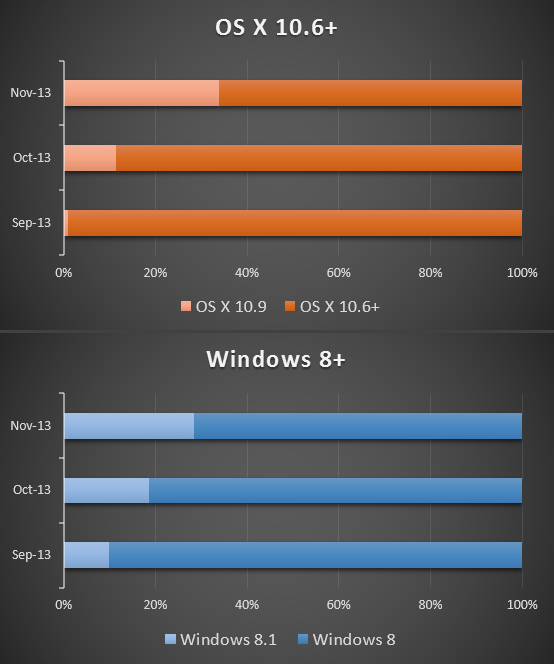Free upgrades pay off for Apple and Microsoft in November

In tech terms, October and November are the doldrums, that quiet period after students return to school and before the holiday shopping frenzy begins.
So it’s not surprising that the latest NetMarketShare numbers on worldwide operating-system usage barely changed in November. Windows usage overall is essentially unchanged, with Windows 8.x and Windows 7 up slightly at the expense of the fading Vista and XP. Collectively, Windows 8 and Windows 8.1 accounted for 9.3 percent of web usage in November, with XP still hovering above the 30 percent mark as the clock ticks closer to its end-of-support date. (See the chart at the end of this post.)
In the browser space, the three leading desktop browsers barely budged, with Internet Explorer at 58.36 percent, Firefox at 18.54 percent, and Google Chrome at 15.44 percent.
There were a few interesting bits of statistical data buried in this month’s data dump, though. Both Microsoft and Apple released upgrades to their flagship operating systems in late October. Windows 8.1 is free to Windows 8 users, and OS X 10.9 (Mavericks) is free to users of OS X 10.6.8 (Snow Leopard), 10.7 (Lion), and 10.8 (Mountain Lion).
So how have those free upgrades gone? After one full month, Apple and Microsoft have successfully convinced roughly 30 percent of their respective installed bases to upgrade. (The exact numbers: 28.4 percent for Windows 8+, 33.9 percent for OS X 10.6+.) This chart shows the percentage of the installed base for each month for the relevant operating system families.

Data provided by > Net Applications
If price isn’t a barrier to an upgrade for either platform, why isn’t the number 100 percent? The obvious reason is that users are rightfully gun-shy of big upgrades like this. The upgrade process is never guaranteed to be successful, even on the much more tightly controlled Apple hardware platform. In Apple’s case, Mavericks came with an assortment of bugs and issues that had even Apple loyalists urging a wait-and-see attitude.
Both companies have a profound interest in moving their customers to the newest version. Support costs drop and managing security is by definition easier if you can concentrate on a single version instead of supporting four major Windows versions, as Microsoft is currently doing.
You can expect to see the shares of Windows 8.1 and OS X Mavericks rise over the next few months. When I update this chart next month, I expect to see the Windows 8.1 numbers significantly higher, as Microsoft and its hardware partners sell tens of millions of new PCs in the holiday season, most of them running Windows 8.1.
But the dream of both companies—of operating systems that update automatically and are never out of date—is still another major release or two away. User inertia and (for Windows users) corporate conservatism will guarantee that.
A quick check of the other big metrics company, StatCounter, shows impressive gains for Windows 8.1 as well, although the percentages differ from the NetMarketShare numbers. StatCounter has the combined share of Windows 8 and 8.1 at 8.6 percent, with roughly 1 in 8 Windows 8 users having upgraded by the end of November.
StatCounter includes mobile operating systems and game consoles in its figures, so it's difficult to compare directly with NetMarketShare numbers. Excluding those operating systems and normalizing the numbers to include only Windows/OS X/Linux/Chrome OS, the share for Windows 8 and 8.1 combined is 9.3 percent, exactly the same as NetMarketShare's report. (StatCounter doesn’t break out figures for OS X versions, so that comparison isn’t possible.)
StatCounter's November figures are also encouraging for the XP-must-die crowd, with XP checking in at 19.3 percent. Both companies show Windows 8 usage outstripping all versions of OS X combined, and the NetMarketShare numbers show that Windows 8.1 alone is used more than any single version of OS X. Oh, and one final tidbit: Chrome OS, which powers Google's Chromebooks, still doesn't appear in sufficient numbers to make the NetMarketShare reports, but StatCounter shows the web-centric Google OS with a 0.05 percent share of usage worldwide, behind PlayStation but ahead of Windows 2000 and Nintendo.
Here is the desktop OS share chart from NetMarketShare.
Data provided by Net Applications
And here is the operating system chart from StatCounter. As I explain earlier, these figures mix desktop OSes, mobile platforms, and game consoles, so the numbers can't be directly compared to those from NetMarketShare.
Data provided by StatCounter